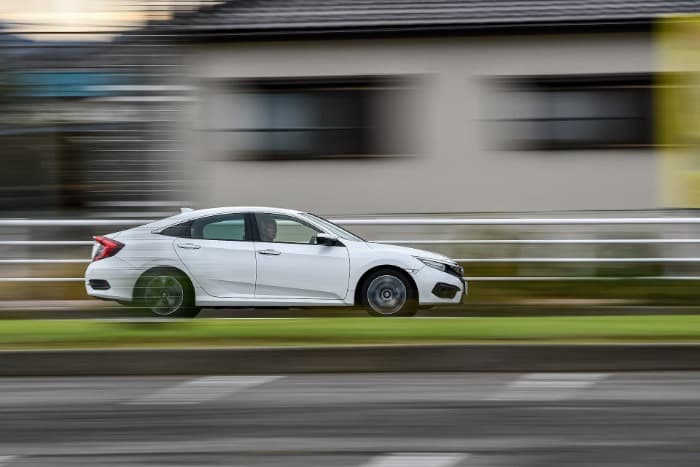Table of Contents
- What is the Honda Civic?
- History of the Honda Civic
- Different types of Honda Civics
- Pros and cons of owning a Honda Civic
- What to look for in the Body of a used civic:
- What to look for in the engine of a used civic:
- What to look for in the tires of a used civic:
- Comparison of different Civics
- Conclusion: which Civic is right for you?
Home » All About The Honda Civic: Ultimate Buying Guide And Comparison
What is the Honda Civic?
The Honda Civic is a line of small cars manufactured by the Japanese company Honda. The first Civic was introduced in 1972 as a two-door model, followed by a three-door hatchback in 1974, and a four-door sedan was added to the lineup in 1976. The Honda Civic is one of the most storied lines of cars ever, right up there with the 240sx, Datsun’s, and other iconic lines.
The Civic has been consistently one of the best-selling cars in the United States since its introduction, and it’s easy to see why. With its reputation for reliability and efficiency, the Civic has long been a favorite among budget-minded buyers.
Today’s Civics are available in a wide range of body styles, powertrains, and trim levels, making it easy to find one that fits your needs and budget. Whether you’re looking for a fuel-efficient commuter or a performance-oriented hot hatch, there’s a Civic for you. Let’s take a look at the best guide to use if you are thinking of buying a civic. Civic keychain looking brand new.
History of the Honda Civic
The Honda Civic is one of the most popular cars on the market. It’s reliable, efficient, and affordable. But what is the history of this iconic vehicle? If you have taken a look at our other article that goes over a lot of the info about Honda Civics , then you have just started to scratch the surface of this line.
The Civic was first introduced in 1973. It was a small car that was designed to be fuel-efficient. The original engine was a 1.5-liter four-cylinder that produced just over 50 horsepower.
The Civic quickly became a popular choice for families and commuters alike. In 1976, Honda released an updated version of the Civic with a larger engine option, and this made the Civic more powerful and fun to drive.
Throughout the years, the Civic has undergone many facelifts and redesigns. However, it has always remained true to its roots as an affordable and reliable car. But with the newest line of Type R civics coming out, the days of economy status might have dropped a bit as they are getting expensive, but their value is going up because, for their price tag, you will be hard-pressed to find anything that comes close.
Different types of Honda Civics
The Honda Civic is a popular car choice for many drivers, with several different types. There are the standard sedan and coupe models and the more sporty Si and Type R versions. Hybrid and electric models are also available for those who want to be more environmentally friendly.
So which one is right for you? It depends on your needs and preferences. The standard Civic model will be a good choice if you’re looking for a basic, affordable car. If you want something with a bit more power and style, go for the Si or Type R. And if you’re interested in saving money on fuel costs, consider the hybrid or electric versions.
Pros and cons of owning a Honda Civic
The Honda Civic is a compact car in production since 1972. It’s one of the most popular cars on the road, and for a good reason. The Civic is reliable, efficient, and affordable. But like any car, it has its pros and cons.
Pros of owning a civic
Here are some of the pros of owning a Honda Civic:
1. Reliability – Hondas are well known for their reliability, and the Civic is no exception. It’s built to last, and you can expect it to run smoothly for many years.
2. Efficiency – The Civic is very fuel-efficient, so you’ll save money at the pump. It’s also environmentally friendly, thanks to its low emissions levels.
3. Affordability – The Civic is one of the most affordable cars on the market.
Comparison of the Honda Civic to other popular cars
Cons of owning a Civic
- Lack of power ( on some models ) -One downside of the Civic is that it doesn’t have much power. The engine is small, so the car can feel underpowered when accelerating or climbing hills. This can be frustrating for drivers who are used to more powerful cars.
- Lower quality of build materials -Another potential issue with the Civic is its build quality. Some owners have reported problems with the interior materials feeling cheap and the paint job chipping easily. These issues are less common in newer models, but they’re something to keep in mind if you’re considering buying an older Civic. But honestly, when you pay a lot less, you can’t expect your car to have massage chairs as a Benz does.
What to look for in the Body of a used civic:
When looking for a used Honda Civic, there are several things to remember. The Body of the Civic is one of the most important aspects to consider. Here are a few things to look for in the Body of a used Civic:
1. Check for rust and corrosion. Rust and corrosion can weaken the car’s Body and lead to severe problems down the road.
2. Inspect the panels and doors for any dents or scratches. Dents and scratches can affect the car’s resale value, so it’s best to avoid them if possible.
3. Make sure all of the lights are working correctly. Headlights, taillights, and brake lights are all critical for safety on the road.
4. Test all of the locks to ensure they are working correctly.
What to look for in the engine of a used civic:
First, ensure that the oil level is where it should be and that there are no leaks. You’ll also want to check the condition of the spark plugs and the air filter. Finally, take the car for a test drive and pay attention to how the engine sounds and feels. Depending on the price, you might want to take the vehicle to a mechanic to get a compression test and other things checked out with a vehicle inspection. But if you pick up a Civic for basically the shell at $500, you can expect to have a bunch of issues.
What to look for in the tires of a used civic:
When purchasing a used Honda Civic, it is important to inspect the condition of the tires. The tires are an essential part of the vehicle and can impact its performance. And again, it depends on the cost here. If you are buying basically a shell, don’t expect brand-new Pirellis on there, so keep that in mind. Here are some things to look for when inspecting the tires of a used Civic:
1. Check for wear and tear. Look for signs of excessive wear, such as cracks or bald spots. This can indicate that the tires need to be replaced.
2. Check the tread depth. The tread depth should be at least 4/32 of an inch; if it is less than this, the tire may need to be replaced.
3. Inspect the sidewalls for damage. Look for cracks or bulges, indicating that the tire has been damaged and may not be safe to use.
4. Make sure that the tire pressure is correct.
Comparison of different Civics
When it comes to choosing a car, there are many things to consider. But if you’re looking for a reliable and affordable option, then the Honda Civic is a great choice. In this guide, we’ll compare different models of the Civic so you can decide which one is right for you.
The Honda Civic has been one of the most popular cars on the market for decades, and it’s known for its reliability, affordability, and fuel efficiency. The Civic comes in various models, including the LX, EX, Si, and Type R.
The LX is the base model of the Civic. It comes with features like 16-inch alloy wheels and automatic headlights. The EX model adds features like heated front seats and a sunroof. The Si model is designed for performance and comes with sport-tuned suspension and 18-inch wheels. Then you have the SIR and evolution into the Type R’s, which are just little value-based rocketships… but we have a whole other article about honda civic type-rs
Conclusion: which Civic is right for you?
When it comes to choosing a Honda Civic, there are many factors to consider. But ultimately, the best Civic for you is the one that fits your needs and budget.
For example, the Civic Hybrid or Natural Gas model might be the best choice if you’re looking for a fuel-efficient car. The Civic Si Sedan or Hatchback will be a good option if you need a lot of space. And if you’re looking for a performance-oriented vehicle, then the Civic Type R would be the best choice.
So, take some time to think about what you need and want in a car. Then use this guide to help you narrow your choices and find the perfect Honda Civic.



